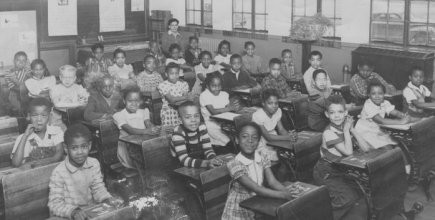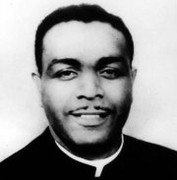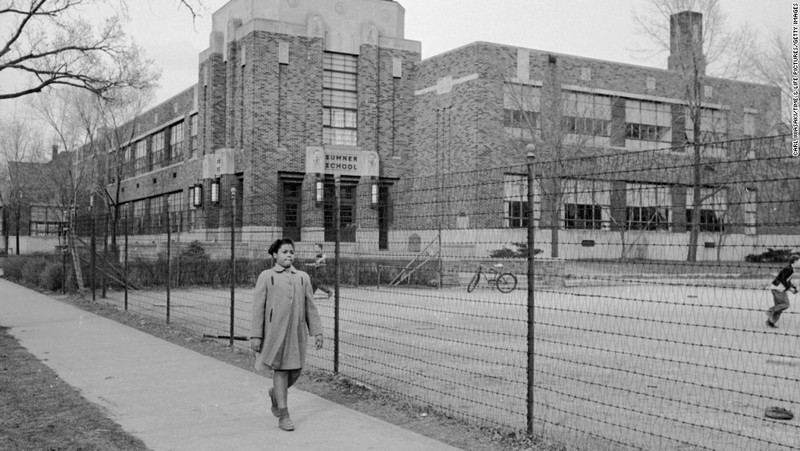Sumner Elementary School, Topeka
Introduction
Text-to-speech Audio
Images
Sumner School - west entrance (today)

The segregated Monroe School, where Linda Brown went to school

Oliver Brown, a part-time minister and plaintiff in the Brown v Board of Education case

Sumner School in the early 1950s, with Linda Brown in foreground

Backstory and Context
Text-to-speech Audio
Esther Brown, a white, liberal woman in the Kansas City suburb of Merriam, became incensed at the more favorable treatment of the local school board towards its white students over its Black children. She urged the local NAACP to take action. At the time, there were 18 white schools in Topeka and only four Black schools; this necessitated many Black schoolchildren traveling very long distances to attend the segregated schools that would accept them. However, the Topeka Superintendent of Schools was a supporter of segregation, and even some African-American teachers supported the status quo, fearing that the schools would fire them, under pressure from white parents, if the schools were ever integrated. The Topeka Secretary of the NAACP wrote the national president of the organization to protest against the "unbearable" situation for Black schoolchildren in the city. African-American attorney Robert Carter, a member of future Supreme Court justice Thurgood Marshall's Legal Defense Fund office, became lead attorney in the case, and he began to look for plaintiffs.
Local welder and part-time minister Oliver Brown was distressed that his daughter Linda had to leave his house at 7:40 each morning and walk through a dangerous switching yard to wait, in all manner of weather, at a poorly-timed bus stop (at which the bus was also often late), in order to be driven over an hour across town to the all-Black Monroe School. Yet the all-white Sumner School was only a few blocks from the Brown home. Brown tried to enroll his daughter in the third grade class at Sumner, but was denied because she was Black. He agreed to be a plaintiff in the case along with twelve other local Black parents. A complaint was filed with the First District Court of Kansas in early 1951.
Esther Brown helped arrange local accommodations for Carter, his legal team and the expert witnesses he had assembled. These witnesses were necessary to make the case to the judges that the entire doctrine of "separate but equal" was flawed: there could be no equality in a segregated school system. University of Kansas psychiatrist Louisa Holt testified that the very fact of segregation created an internalized "sense of inferiority" among Black students. After much similar testimony, the District Court ruled unanimously in favor of the defendants, the Topeka Board of Education, but only because of the Supreme Court precedent of Plessy v. Ferguson. The judges' sympathies, however, were plainly with the plaintiffs (the parents in the case), and they expressed their opinion in a famous passage, influenced by Ms. Holt's testimony: "Segregation of white and colored children in public schools has a detrimental effect upon the colored children. The impact is greater when it has the sanction of law; for the policy of separating the races is usually interpreted as denoting the inferiority of the Negro group. A sense of inferiority affects the motivation of a child to learn."
In December 1952, the Kansas case was "bundled" with four other cases - from South Carolina, Virginia, Delaware and the District of Columbia - all five arguing against the constitutionality of segregation. At that time, only four of the nine justices on the court were in favor of overturning segregation. However, they voted to have the case re-argued during the following Supreme Court term, and in the interim, conservative Chief Justice Vinson died of a heart attack and was replaced by liberal Earl Warren. Thurgood Marshall was part of the plaintiffs' legal team, arguing the South Carolina case, but as one author observed, after the replacement of Vinson with Warren, "Marshall could have stood up there and recited 'Mary Had a Little Lamb' and the result would have been exactly the same." In May 1954, the Supreme Court issued the unanimous Brown v. Board of Education decision (Warren had discouraged the conservative justices from dissenting), which concluded that segregation violated the Equal Protection Clause of the U.S. Constitution, ending legal segregation in the public schools. Within three years of the decision, the integration of Topeka's schools was completed. Ironically, by the time the decision was issued, Linda Brown and the other twelve child plaintiffs had already moved on to integrated junior high schools. However, Linda's two younger siblings were able to benefit from the integration of Topeka's elementary schools. Oliver Brown died in 1961.
The Sumner Elementary School was originally designed as a two-story, brick structure with 13 rooms, a tower, a basement, and auditorium. The exterior is enhanced by stone decorative bas reliefs in the Art Deco style. In the years since its construction, the school underwent a number of renovations. Despite being added in 1987 to the National Register of Historic Places, the school was closed in 1996 and subsequently suffered from vandalism and neglect. The Rev. W. R. Portee, minister of a nondenominational Christian church based in Los Angeles, purchased the Sumner school building at a city auction in April 2009 for $89,000. However, plans to turn the school into a civil rights monument have not yet been fulfilled, and it still lies vacant as of May 2017.
Sources
Hagedorn-Krass, Martha. "Sumner Elementary School & Monroe Elementary School." National Park Service - NRHP Nomination Form. Publication Date: 6/20/91. Access Date: 4/22/17. URL: https://npgallery.nps.gov/GetAsset/78cfebc8-5f30-4469-a7b3-2e864d3a73d9.
Saulny, Susan. "In Purchase of School, Hopes of Saving a Neglected Monument." The New York Times. Publication Date: 7/19/09. Access Date: 4/22/17. URL: http://www.nytimes.com/2009/07/20/us/20sumner.html.
"Sumner Grade School - Kansas Memory." Kansas Historical Society. Access Date: 4/22/17. http://www.kansasmemory.org/item/208673.
Linder, Prof. Douglas O. "The Brown v. Board Of Education Of Topeka trial: An Account." Access Date: 4/22/17. URL: http://www.famous-trials.com/brownvtopeka/666-home.
“Brown v. Board of Education of Topeka” MSN Encarta. Access Date: 5/7/17. URL: http://www.webcitation.org/5kwQQveNZ?url=http%3A%2F%2Fencarta.msn.com%2Fencyclopedia_761588641%2Fbro...
"Black/White & Brown: Brown versus the Board of Education of Topeka (Transcript)." KTWU/Channel 11 - Topeka, KS. Publication Date: 5/3/04. Access Date: 5/7/17. URL: https://web.archive.org/web/20050910014053/http://brownvboard.org/video/Blackwhitebrown.
Anderson, Ric. "Many people part of local case." cjonline.com. Publication Date: 5/9/04. Access Date: 5/7/17. http://cjonline.com/stories/050904/04b_localcase.shtml#.WQ9ip-XyuM8.
"Brown v. Board of Education Fast Facts." CNN Library. Publication Date: 4/28/17. Access Date: 5/7/17. http://www.cnn.com/2013/07/04/us/brown-v-board-of-education.
